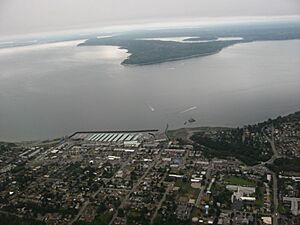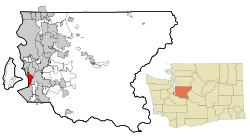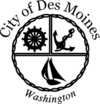Des Moines, Washington facts for kids
Quick facts for kids
Des Moines, Washington
|
||
|---|---|---|

Aerial view
|
||
|
||
| Nickname(s):
"The Waterland City"
|
||

Location of Des Moines, Washington
|
||
| Country | United States | |
| State | Washington | |
| County | King | |
| Founded | 1867 | |
| Incorporated | June 17, 1959 | |
| Government | ||
| • Type | Council–manager | |
| Area | ||
| • Total | 7.408 sq mi (19.187 km2) | |
| • Land | 6.414 sq mi (16.611 km2) | |
| • Water | 0.994 sq mi (2.575 km2) | |
| Elevation | 190 ft (60 m) | |
| Population
(2020)
|
||
| • Total | 32,888 | |
| • Estimate
(2023)
|
31,988 | |
| • Density | 4,988.32/sq mi (1,926.01/km2) | |
| Time zone | UTC−8 (Pacific (PST)) | |
| • Summer (DST) | UTC−7 (PDT) | |
| ZIP Codes |
98148, 98198
|
|
| Area code(s) | 206 | |
| FIPS code | 53-17635 | |
| GNIS feature ID | 2410327 | |
Des Moines (say "də-MOYNZ") is a city in King County, Washington, United States. It is located right on the eastern shore of Puget Sound. In 2020, about 32,888 people lived there.
Des Moines is part of the larger Seattle metropolitan area. It is surrounded by other cities like Federal Way to the south and Burien to the north.
The city is special because it has easy access to the water. It has a fun marina where you can dock boats, launch them, or go fishing from the pier. Saltwater State Park is also in Des Moines. It is a very popular state park on Puget Sound. You can also find a boardwalk and an aquarium in the Redondo neighborhood.
Contents
History of Des Moines
Early Explorers and Settlers
The area that is now Des Moines was first explored by Europeans in 1792. This happened during a trip by British naval Captain George Vancouver. The first Americans to visit were part of an expedition led by Charles Wilkes.
The first known settler was John Moore, who arrived around 1867. He claimed land there in 1872.
How Des Moines Got Its Name
In 1887, a person named F.A. Blasher convinced friends from his hometown of Des Moines, Iowa, to help. They wanted to build a new town on Puget Sound. The Des Moines Improvement Company was formed to do this work. In 1889, the land was divided into lots and sold. Early jobs in the community were mostly in lumber mills.
Transportation and Growth
In the early days, people traveled to Des Moines by water. Small boats, called the "mosquito fleet," connected the town to Seattle, Tacoma, and Vashon. The first road, called the Brick Highway, was finished in 1916. A car ferry service also started in 1916, connecting Des Moines to Portage. This ferry ran until 1921. Before World War II, farming was a big part of the local economy.
After the war, more people started moving to Des Moines. The city officially became incorporated on June 17, 1959. This meant it could manage its own services better.
Modern Developments
The city's marina, which holds 838 boats, opened in 1970. A long fishing pier was added to the marina in 1980.
Because the Seattle–Tacoma International Airport is only about 2 miles north, some properties in Des Moines have been bought by the airport due to aircraft noise.
In 1982, Des Moines grew by adding the nearby community of Zenith. Zenith was first a farming area, then became a place where many Boeing workers lived.
Geography and Landscape
Des Moines covers about 7.4 square miles. Most of this area is land, with some water.
The city's land gently slopes down towards Puget Sound. This means many homes have clear views of the sound and Vashon Island. Two creeks, Des Moines Creek and Massey Creek, cut deep valleys into this slope.
People of Des Moines
Population Overview
In 2020, Des Moines had 32,888 residents. The city has an estimated 12,369 households. The average household has about 2.57 people.
The median household income in Des Moines is about $81,362. Most people in the city have a high school diploma, and many have a college degree.
Diversity in Des Moines
Des Moines is a diverse city. In 2020, the population included people from many different backgrounds. About 47% of residents were White, 12% were Black or African American, and 12.6% were Asian. About 17.7% of the population identified as Hispanic or Latino.
Education in Des Moines
Schools for Kids
Most students in Des Moines attend schools in the Highline Public Schools district. Some neighborhoods, like Woodmont and Redondo, are part of the Federal Way School District.
There are several elementary schools in Des Moines, including Des Moines Elementary and Woodmont Elementary. Pacific Middle School and Mount Rainier High School are the main secondary schools.
Private schools like St. Philomena Catholic School and Holy Trinity Lutheran School also serve students.
Colleges and Higher Education
Highline College is located in Des Moines. It offers many different programs for students.
Central Washington University also has a branch campus, CWU-Des Moines. It is located on the Highline College campus and offers bachelor's and graduate degrees.
Parks and Recreation
Saltwater State Park is a popular spot in Des Moines. It offers beautiful views and outdoor activities.
City Government
Des Moines uses a council-manager system. This means the city council makes decisions, and a city manager handles the daily operations.
The Des Moines Police Department keeps the city safe. It has 30 police officers.
Getting Around Des Moines
Major Roads
Several main roads serve Des Moines. Interstate 5 is to the east and connects to Seattle and Tacoma. State Route 99 runs along the east side of the city. State Route 509 goes through downtown, and State Route 516 leads to Kent.
Public Transportation
King County Metro provides bus service in Des Moines. You can take buses to nearby areas like the Burien Transit Center and Kent station. There are also express buses to Seattle and Tacoma.
For train travel, the nearest Link light rail station is Angle Lake. A shuttle bus connects downtown Des Moines to this station. A new light rail station, the Kent Des Moines station, is planned to open near Highline College in 2026.
In August 2022, the city started a test passenger ferry service. It connected the Des Moines Marina to Bell Harbor Marina in Downtown Seattle.
City Landmarks
Des Moines has some special places that are recognized as landmarks:
| Landmark | Built | Listed | Address | Photo |
|---|---|---|---|---|
| Des Moines Beach Park (the former Covenant Beach Bible Camp) | 1917–1931 | 2005 | Cliff Ave. and 220th St. 47°24′26″N 122°19′43″W / 47.40722°N 122.32861°W |
 |
| WPA Park Buildings Des Moines Activity Center |
1939–1940 | 1984 | 220th St. and 11th Ave S. 47°24′18″N 122°19′25″W / 47.40500°N 122.32361°W |
 |
Notable People
- Gregory Carroll, an opera singer
- Peter H. Gregory, an expert in information security and a writer
- Darwin Jones, a professional soccer player
See also
 In Spanish: Des Moines (Washington) para niños
In Spanish: Des Moines (Washington) para niños




